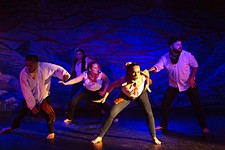Culture Club
Dances inspired by three legendary women cross cultures and generations
By Jonelle Seitz, Fri., Feb. 27, 2009
War, spirituality, desperation, passion, culture: All are forces driving a new collaborative dance work by a formidable trio of local dancer-choreographers: Anuradha Naimpally, Toni Bravo, and Sharon Marroquín. Women: Voices and Whispers, produced by Austin Dance India, will explore facets of women's realities through the essences of three powerful female figures in history, as captured by three distinct choreographic voices. A cast of dancers including schoolchildren and octogenarians will perform movement based in the languages of modern and classical Indian dance, accompanied by 13th century sacred music, contemporary compositions, and the songs of Edith Piaf.
The choreographers are all teachers as well as artists, which may explain their focus on the intergenerational. In a conversation about the project, it became evident that their roles render them all at once creators, interpreters, and protectors of the cultures they pass down. The performance, says Naimpally, aims to expose women's experiences and the human condition in general at the intersection of the broadness of culture, the horizontal, and cultural lineage, the vertical. That is, in mathematical terms, the origin.
Austin Chronicle: After at least a decade of working in overlapping circles and crossing paths, you're collaborating as a trio for the first time. How did this project come about?
Anuradha Naimpally: Well, I had this idea of women, something with women together, and the three of us have such different things to bring to the table, and so we thought we'd start with the three of us. And then – I think in September – we started meeting down at Central Market on Sundays, and we would just talk about what it was, and all we knew was that it was about women. And it started with that and the voices and whispers, and then it expanded.
Toni Bravo: And we talked about other things than dance, too.
Naimpally: Yeah, just like women at the table. How girls share, how women share ...
Bravo: We'd talk about regular life. So we started thinking: "That may be it; that may be the topic. Let's talk about the voice of all women or every woman we know."
Naimpally: But then we needed a starting point, for sort of the inspiration for the whole thing, and in our discussions we discovered that there were women we were reading about or had admired or had in mind in some way. So we [each] chose a woman in history – and not necessarily just that woman's life but that woman's spirit and what it represents. So it's that passing of the legend, also.
Bravo: Their legacy and how their legacy has reached us.
Naimpally: And how that's expressed.
Sharon Marroquín: Well, when we were talking about that – and I don't remember who came up with the idea, but it was one of you two, because it wasn't me – I remember thinking to myself, "Oh, I know who I could do," because it's someone who for several years I've had the intention of making a dance about. So the woman I chose to become inspired by is Saint Teresa of Avila. And I've read her biography, and I've read some of her writings, and I've always been fascinated by her and always thought, "I want to do a dance about her." But, you know, it never happened, so I remember hearing them talk and thinking, "I know, I know who I would do!" So, for me, it was very welcome, because it was an opportunity to do something that I'd been interested in.
Naimpally: [To Bravo] And you had already said something about Edith.
Bravo: Yeah, the same with me. I had said that I wanted to talk about someone special, and in the back of my head, there's always been this thing about Edith Piaf's music but also the very difficult life that she lived and how, in spite of everything, she continued with enormous love and passion. To me, that's very inspiring. So I had always planned to do something about Piaf – hoping, I guess, more than planning.
Naimpally: For me it was different, because I didn't have anybody in mind at that point. But suddenly, when we were talking, Jhansi Ki Rani, the queen of Jhansi, came into my head. She's a woman who lived in 19th century India, when the British East India Company had assumed military rule over many parts of India. And during the civil rebellion and mutiny of 1857, she played a pivotal role in the attempt to retain land in the hands of the rightful Indian rulers. She was actually a warrior, and she went into battle, and she literally died in battle at a very young age. But, being from India but growing up in North America, I never really studied, formally, Indian history in school, and I just know snippets about it or what I've read. So this was an opportunity for me to learn more about her and present something historical that's very important. She didn't live very long, but her legend is just enormous in India. Schoolchildren still memorize the famous poem about her – I mean, she's enormous. There are statues of her all over.
AC: So you had this huge concept, then reached back to the historical figures to illuminate it.
Naimpally: I think, maybe, to bring it to light.
Bravo: Also, it was an opportunity for us to concentrate on that one personality that was, for one reason or another, so attractive to each one of us. But it also helped us to be able to represent different kinds of women with different voices, with different intents. And because we started talking about legacy, we also thought we needed to figure out a way to talk in terms of how that figure has influenced me and how I have influenced, maybe for that reason, in a certain way, the next generations. And so it was a good way to narrow our narrative, as opposed to having to talk in general about women.
AC: Instead of just "Women: Who are they?"
Marroquín: Yeah, well, women are so many things. I mean, they're wives, and they're mothers, and they're petty, and they're deep, and they're spiritual, and they're passionate. There are so many different facets that I think choosing these three women was a way of homing in on three aspects of women. They're probably present in all women, to one degree or another, but we're focusing in on three women who really embodied them.
And I think the fact that all three of us are teachers also has something to do with it. You know, the youngest in the cast is 6, and I chose some of my students, and Toni's got her students in it, and Anu's got her students in it, so we're – you know, talking about passing down, that's what we're actually doing! You know, we're doing it! [To Naimpally] Yesterday, I was watching your two young women dancing behind you, and it was amazing to think that they learned that from you.
AC: What do the stories of these historical figures bring to conversation? I mean, are we talking about feminism?
Marroquín: I think we haven't even mentioned that at all.
Naimpally: I don't think this show has anything, really, to do with the traditional sense of feminism. It's just a celebration of spirit through these women, how they expressed themselves and how they live on.
Bravo: Well, if you think in terms of their significance, each of them is really, really at a point in history in which things changed because of them. I know Teresa [of Avila] was a very different religious woman than others had been up until that point. So she changed things in a sense.
Marroquín: She certainly didn't fit the mold.
Bravo: Piaf was definitely not the singer that Europe had been seeing up until that point. She started doing things that sounded like jazz and blues when there was no jazz or blues. And obviously this queen, Jhansi Ki Rani, she was a warrior.
Naimpally: In the 1850s, women were not on horseback wielding weapons.
Marroquín: And did you mention that she dressed as a man to go out and fight?
Naimpally: She did, probably not to stick out. And carrying her child with her.
Bravo: But I don't think they were trying to be one thing or the other. They were just acting out of themselves and out of the circumstances.
Women: Voices and Whispers runs Saturday, Feb. 28, 8pm, and Sunday, March 1, 2pm, at AustinVentures StudioTheater, 501 W. Third. For more information, call 474-8497 or visit www.austindanceindia.com.









